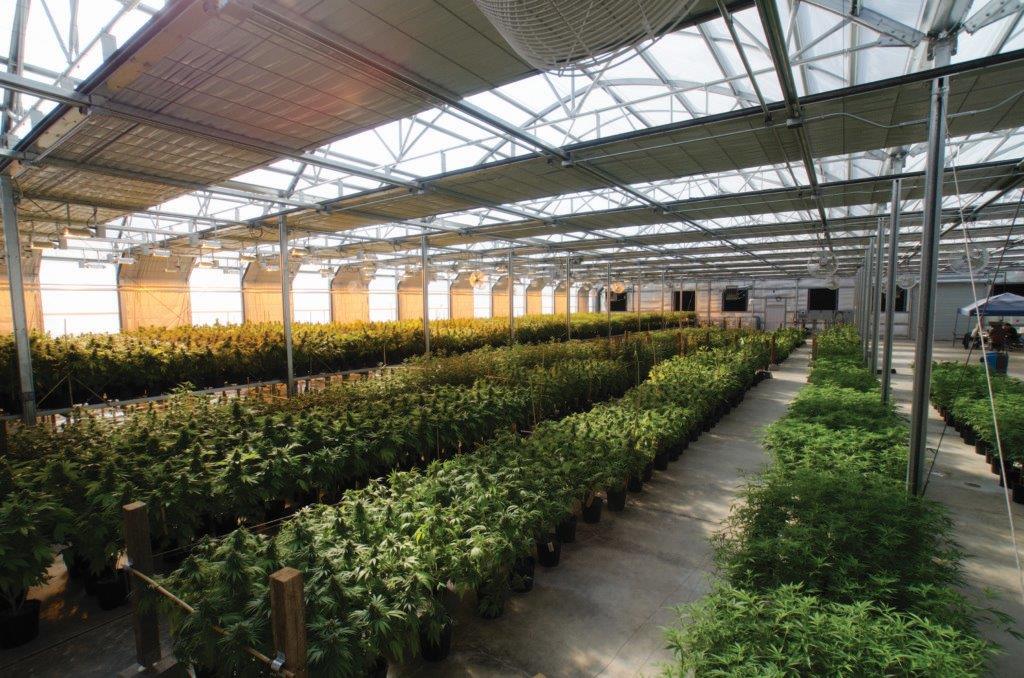Whether growers use automated blackout systems or do-it-yourself tarps, proper design is vital for success with light deprivation
By Karli Petrovic
Many horticulture experts believe greenhouses and light deprivation techniques are the future of cannabis cultivation.
“It’s where so much of the industry is going right now,” Forever Flowering Greenhouses president Jonathan Valdman says.
Ten years down the road — if not sooner — growers who want to be industry leaders will need to employ light deprivation correctly, right from the start.
Industry experts say the biggest perks of using light deprivation are a consistent, high-quality crop even in inclement weather, anywhere from one to four additional harvests per year, and giving operations the ability to control their own destinies. Because growers who use light dep can better plan production cycles, they are able to beat the market rush at the back end of a full-term cycle, leading to a higher price point in the process.
So why isn’t everyone doing it? There are a couple of caveats, the first of which is price. Installing effective light deprivation equipment isn’t cheap.
“Automation is the best way to do light deprivation, but the downside is capital investment,” says Matthew Cohen, CEO of TriQ Systems. “As the market evolves, people can get by with manual systems, but any company that is successful long-term needs automation.”
There are cost-effective ways to get around investing in a state-of-the-art, fully-automated shading system, but as Cohen notes, choosing a low-tech alternative can create additional problems. For example, the labor costs and potential for human error associated with maintaining the proper 12-hours-on, 12-hours-off schedule can be time-intensive and create a financial burden.
Industry experts also emphasize the importance of having a set plan before diving headfirst into the complex world of light deprivation. A variety of horror stories illustrate how good intentions can quickly lead to construction hell.
“There have been a lot of mistakes made,” says Horticultural Services’ Howard Hughes. Shading systems that are not designed specifically to match the structure is one of the common pitfalls, Hughes says.
“A lot of greenhouses were cold frames and not necessarily built for these systems,” he explains. “Many times the structure isn’t strong enough for the retrofitting. Light dep gets very expensive unless growers plan for it in the beginning.”
The planning and research part of creating a viable five-year plan can be overwhelming, particularly in the cannabis industry, where laws and the entire legal marketplace are evolving faster than anybody could have predicted. Equipment manufacturers recommend that growers do their homework by consulting with trustworthy companies and experts.
“It’s important to work with a company that knows what they’re doing and knows that product really well,” says Jon Kozlowski, cannabis greenhouse specialist at Growers Supply. Speaking to manufacturers who take the time to understand a grower’s budget, setup and unique needs can also be a lifesaver, especially when the structure needs to comply with specific building codes and requirements.
“This is regularly overlooked by growers, many of whom are surprised by expensive road blocks,” Kozlowski says. “No growing situation is the same. We’ve completed projects that have had some pretty specific requirements and requests.”
After growers consider their setup, budget and future plans, they’re ready to select from a number of options, ranging from do-it-yourself setups to advanced automated systems.
“For some growers, the simpler designs, lower costs and ease of hoop house construction are especially appealing,” says Greg Ellis, regional sales director at Nexus Corporation.
Many growers are choosing greenhouses over indoor facilities because greenhouses can harness the power of the sun, saving businesses a great deal of money on electricity costs.
“Growers are moving outside the warehouse mentality,” Valdman says. “A greenhouse allows them to lower the cost of production and the cost to the environment, which is a great way to add value to the product. I like to see cannabis producers becoming responsible growers.”
However, even with greenhouses and automated systems, a grower’s success depends on a properly designed and installed system. Blackout curtains must fit the structure’s shape without bunching or casting shadows. Ellis says galvanized steel framing, rack-and-pinion devices, automated motors and fabric curtains are essential for proper light deprivation.
While some growers remain adamant about the importance of total blackout, this is one piece of conventional cannabis-growing wisdom that’s being challenged as the industry evolves. The perception is that having any amount of light — as opposed to the pure darkness of a warehouse — is going to cause undesirable characteristics in the plants. Not everybody agrees with this belief.
“The eye sees more light than a plant sees,” Valdman says. “At zero lumens of light, we can still see. Growers don’t need 100% darkness for light dep, and we’ve found that minor pinholes that create starlight in the tarps aren’t an issue.”




